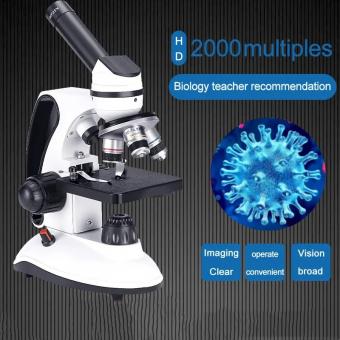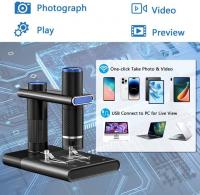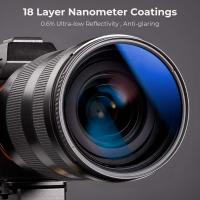What Strength Microscope To See Bacteria ?
To see bacteria, a microscope with a magnification of at least 400x is typically recommended. This level of magnification allows for the visualization of individual bacterial cells and their structures. However, it is important to note that the type of microscope used can vary depending on the specific requirements of the observation. For example, a compound light microscope is commonly used for observing bacteria, while electron microscopes can provide even higher magnification and resolution.
1、 Light Microscopy: Resolving Bacteria with Compound Light Microscopes
Light microscopy is a widely used technique for observing bacteria due to its simplicity, cost-effectiveness, and ability to provide valuable information about bacterial morphology and behavior. Compound light microscopes are commonly used for this purpose, as they offer sufficient magnification and resolution to visualize bacteria.
The resolution of a microscope determines its ability to distinguish two closely spaced objects as separate entities. Bacteria are typically between 0.2 and 2 micrometers in size, and to visualize them clearly, a microscope with a resolution of at least 0.2 micrometers is required. Compound light microscopes can achieve this level of resolution, allowing researchers to observe bacteria in detail.
The magnification power of a microscope determines how much larger the image of the bacteria appears compared to its actual size. For most bacteria, a magnification of 1000x is sufficient to observe their morphology and cellular structures. Compound light microscopes can easily achieve this level of magnification, making them suitable for studying bacteria.
It is worth noting that advancements in microscopy technology have led to the development of high-resolution techniques such as super-resolution microscopy and electron microscopy. These techniques offer even greater magnification and resolution, allowing for more detailed observations of bacteria. However, they are often more complex and expensive than compound light microscopy, making them less accessible for routine bacterial studies.
In conclusion, a compound light microscope with a resolution of at least 0.2 micrometers and a magnification of 1000x is suitable for observing bacteria. While more advanced microscopy techniques exist, compound light microscopy remains a widely used and effective tool for studying bacteria.

2、 Electron Microscopy: Visualizing Bacteria with Transmission Electron Microscopes
To visualize bacteria, a transmission electron microscope (TEM) is typically used. TEMs are powerful tools that can provide detailed images of bacteria at the nanoscale level. These microscopes use a beam of electrons to illuminate the sample and create an image.
The strength of a microscope is often measured by its resolution, which refers to the ability to distinguish between two closely spaced objects. In the case of bacteria, which are typically around 1-10 micrometers in size, a high-resolution microscope is required to visualize their intricate structures.
The resolution of a TEM is much higher compared to other types of microscopes, such as light microscopes. It can achieve resolutions down to a few nanometers, allowing for the visualization of individual bacterial cells and their internal components. This level of detail is crucial for studying the morphology, structure, and behavior of bacteria.
Moreover, TEMs can also provide information about the ultrastructure of bacteria, including the arrangement of cell walls, flagella, pili, and other cellular components. This information is essential for understanding the function and behavior of bacteria.
It is worth noting that advancements in electron microscopy techniques have further improved the visualization of bacteria. For example, cryo-electron microscopy (cryo-EM) allows for the imaging of bacteria in their native, hydrated state, providing more accurate and detailed information about their structure and function.
In conclusion, to visualize bacteria, a transmission electron microscope is required. The high resolution and advanced imaging techniques of TEMs enable scientists to study the intricate structures and ultrastructure of bacteria, leading to a better understanding of their biology and potential applications in various fields.

3、 Scanning Probe Microscopy: High-Resolution Imaging of Bacteria at Nanoscale
Scanning Probe Microscopy (SPM) is a powerful technique that allows for high-resolution imaging of bacteria at the nanoscale. SPM encompasses various microscopy techniques, including Atomic Force Microscopy (AFM) and Scanning Tunneling Microscopy (STM), which can provide detailed information about the surface topography and properties of bacteria.
To see bacteria using SPM, the appropriate strength of the microscope depends on the specific requirements of the study. AFM, for example, can achieve sub-nanometer resolution and is commonly used to image bacteria. It operates by scanning a sharp probe over the surface of the sample, measuring the forces between the probe and the bacteria to create a topographic image. AFM can provide valuable insights into the morphology, structure, and mechanical properties of bacteria.
In recent years, advancements in SPM techniques have further enhanced the imaging capabilities. For instance, high-speed AFM allows for real-time imaging of dynamic processes occurring on the bacterial surface, such as cell division or bacterial motility. Additionally, the development of multifunctional probes has enabled the simultaneous acquisition of chemical and mechanical information, providing a more comprehensive understanding of bacterial behavior.
It is important to note that the strength of the microscope alone is not the sole determinant of the quality of bacterial imaging. Factors such as sample preparation, imaging conditions, and data analysis techniques also play crucial roles. Moreover, the choice of microscopy technique should be tailored to the specific research question and the properties of the bacteria under investigation.
In conclusion, SPM, particularly AFM, is a powerful tool for high-resolution imaging of bacteria at the nanoscale. The appropriate strength of the microscope depends on the specific requirements of the study, and recent advancements in SPM techniques have further improved the imaging capabilities. However, it is essential to consider various factors beyond microscope strength to obtain accurate and meaningful results.

4、 Confocal Microscopy: 3D Visualization of Bacteria with Laser Scanning Microscopes
Confocal microscopy is a powerful imaging technique that allows for the three-dimensional visualization of bacteria using laser scanning microscopes. This technique provides high-resolution images of bacteria, enabling researchers to study their structure, behavior, and interactions with other organisms or their environment.
To see bacteria using confocal microscopy, a microscope with a suitable magnification and resolution is required. The strength of the microscope depends on the specific requirements of the study. In general, a microscope with a magnification of at least 1000x is recommended to observe bacteria effectively. However, higher magnifications, such as 2000x or even 4000x, may be necessary to visualize smaller bacteria or to study specific details of their structure.
Additionally, the resolution of the microscope is crucial for observing bacteria. The resolution determines the level of detail that can be seen in the images. A microscope with a high numerical aperture (NA) and a small pixel size is preferred for achieving high-resolution images of bacteria. The NA determines the ability of the microscope to gather light, and a higher NA allows for better resolution.
It is important to note that the field of microscopy is constantly evolving, and new advancements are being made to improve the visualization of bacteria. For example, super-resolution microscopy techniques, such as stimulated emission depletion (STED) microscopy or structured illumination microscopy (SIM), can provide even higher resolution images of bacteria, allowing for the observation of subcellular structures and molecular interactions.
In conclusion, to visualize bacteria using confocal microscopy, a microscope with a magnification of at least 1000x and a high-resolution capability is recommended. However, the specific requirements may vary depending on the study and the size of the bacteria being observed. Researchers should consider the latest advancements in microscopy techniques to enhance their ability to visualize and study bacteria effectively.








































There are no comments for this blog.